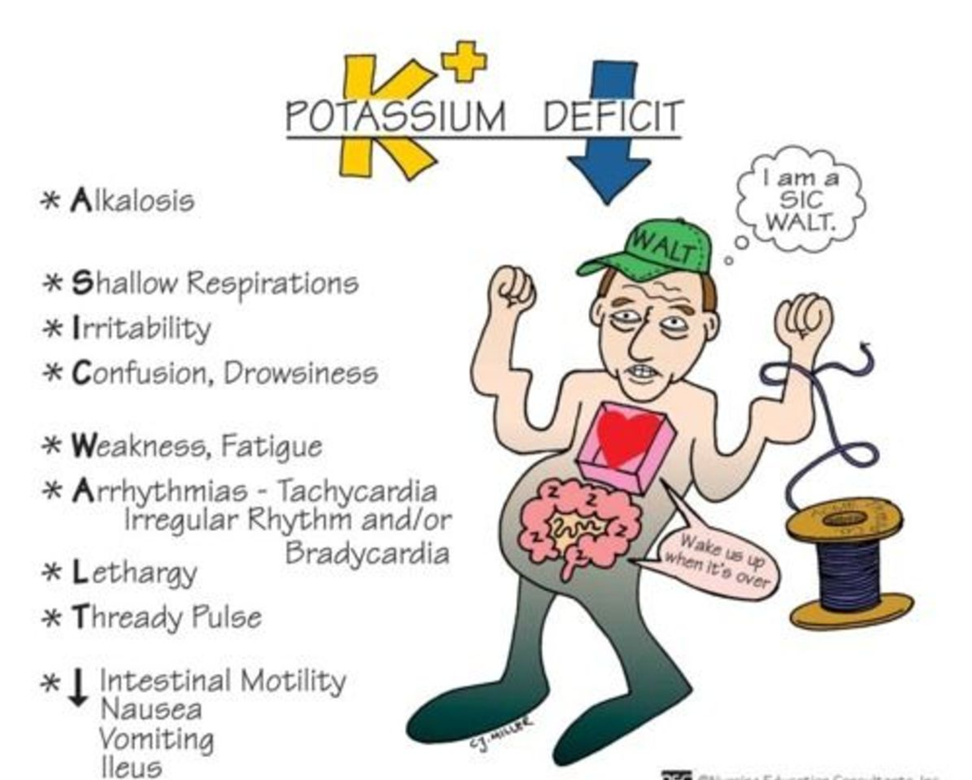A nurse is caring for a client who has COPD.
Medication
Indacaterol 75 mcg, one inhalation daily
Acetylcysteine 20% solution 3 to 5 ml nebulizer every 6 to 8 hr while awake
Select the 5 findings that require follow-up.
Disorientation
Barrel-shaped chest
Yellow sputum
Nebulizer use
Ankle edema
SaO2 92%
Clubbing of fingers
Correct Answer : A,B,C,E,F
A. Disorientation:
This may indicate a neurological or cognitive issue and requires further assessment.
B. Barrel-shaped chest:
This is a characteristic finding in COPD, but any change or worsening may need evaluation.
C. Yellow sputum:
Yellow or greenish sputum may indicate an infection, and follow-up is needed.
D. Nebulizer use:
Nebulizer use is part of the prescribed treatment.
E. Ankle edema:
Edema can be a sign of heart failure or other cardiovascular issues and should be investigated.
F. SaO2 92%:
Oxygen saturation of 92% is below the normal range. It may indicate respiratory compromise and needs attention.
G. Clubbing of fingers:
While clubbing can be associated with chronic respiratory conditions, it is not an immediate concern.
H. Lives alone:
Living alone may impact the client's support system but does not require immediate medical attention.
Nursing Test Bank
Naxlex Comprehensive Predictor Exams
Related Questions
Correct Answer is A
Explanation
A. Fatigue: Hypokalemia (low potassium levels) can lead to fatigue and weakness. Potassium is essential for proper muscle and nerve function, and a deficiency can result in muscle weakness and decreased energy levels.
B. Pitting edema: Pitting edema is more commonly associated with fluid retention, which can occur in heart failure. Hypokalemia is not typically a direct cause of pitting edema.
C. Dyspnea: Dyspnea (shortness of breath) is a symptom commonly associated with heart failure, and while potassium imbalance can affect cardiac function, it is not a specific manifestation of hypokalemia.
D. Oliguria: Oliguria (decreased urine output) is not a typical manifestation of hypokalemia. However, it can be associated with heart failure and other renal conditions.

Correct Answer is D
Explanation
Correct answer: D
A.Elevate the head of the bed 45":Do not elevate the head of the bed more than 15 degrees.Elevating the head of the bed can increase the risk of bleeding from the insertion site.
B.Keep the affected leg slightly flexed: The affected leg should be kept straight to prevent movement at the insertion site, which can cause bleeding
C. Keep the client NPO for 4 hr: There is typically no need to keep the client NPO for an extended period after a cardiac catheterization. However, individual protocols may vary, and the nurse should follow the specific instructions provided by the healthcare provider.
D.Have the client lie flat in bed: After a cardiac catheterization, it is important to keep the client lying flat to prevent bleeding or hematoma formation at the catheter insertion site. This position helps to maintain pressure on the insertion site, particularly if the catheter was inserted through the femoral artery.
Whether you are a student looking to ace your exams or a practicing nurse seeking to enhance your expertise , our nursing education contents will empower you with the confidence and competence to make a difference in the lives of patients and become a respected leader in the healthcare field.
Visit Naxlex, invest in your future and unlock endless possibilities with our unparalleled nursing education contents today
Report Wrong Answer on the Current Question
Do you disagree with the answer? If yes, what is your expected answer? Explain.
Kindly be descriptive with the issue you are facing.
